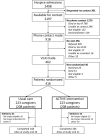Hospice Family Caregiver Involvement in Care Plan Meetings: A Mixed-Methods Randomized Controlled Trial
- PMID: 27465403
- PMCID: PMC5272916
- DOI: 10.1177/1049909116661816
Hospice Family Caregiver Involvement in Care Plan Meetings: A Mixed-Methods Randomized Controlled Trial
Abstract
Background and objective: Untrained family caregivers struggle with complicated medical management regimens for hospice patients. An intervention was tested to improve caregiver's perception of pain management and patient's pain.
Design, setting, and participants: The intervention was tested with a 2-group (usual care vs intervention) randomized controlled trial using parallel mixed-methods analysis of 446 caregivers in 3 Midwestern hospice programs representing rural and urban settings.
Intervention: Web conferencing or telephones were used to connect caregivers with the hospice care team during care plan meetings.
Measurements: Caregiver's perceptions of pain management were the primary outcome. Secondary outcomes included caregiver quality of life, patient's pain, and anxiety. Video recordings, field notes, and caregiver and staff interviews provided qualitative data.
Results: The overall perception of pain management was not changed by the participation in hospice team meetings. Perceptions of fatalism improved for intervention participants, and the intervention participants perceived their patients' pain was better controlled than those in the control group. The intervention was found to be feasible to deliver in rural areas. Caregiver's anxiety and patient's pain were correlated ( r = .18; P = .003), and subanalysis indicated that caregivers of patients with cancer may benefit more from the intervention than other hospice caregivers. Qualitative analyses provided understanding of caregiver's perceptions of pain, cost, and facilitators and barriers to routine involvement of family in care plan meetings. Limitations and Conclusion: The hospice philosophy is supportive of caregiver involvement in care planning, and technology makes this feasible; the intervention needs modification to become translational as well as additional measurement to assess effectiveness. Caregiver education and emotional support should occur outside the meeting, and a strong leader should facilitate the meeting to control efficiency. Finally, the intervention may benefit caregivers of patients with cancer more than others.
Keywords: cancer; caregiver; hospice; interdisciplinary teams; pain; randomized controlled trial.
References
-
- National Hospice and Palliative Care Organization Facts and Figures: Hospice Care in America 2015. 2015
-
- National Alliance for Caregiving 2015 Pages http://www.caregiving.org/wp-content/uploads/2015/05/2015_Caregivinginth... on April 14 2016.
-
- Institute of Medicine . Dying in America: Improving Quality and Honoring Individual Preferences Near the End of Life. National Academies Press; Washington, DC: 2014. - PubMed
-
- Centers for Medicare and Medicaid Services Medicare and Medicaid Programs: Hospice Conditions of Participation. 2008 42 CFR 418. - PubMed
-
- Parker Oliver D, Porock D, Demiris G, Courtney K. Patient and family involvement in hospice interdisciplinary teams. J Palliat Care. 2005;21(4):270–6. - PubMed
Publication types
MeSH terms
Grants and funding
LinkOut - more resources
Full Text Sources
Other Literature Sources
Medical


